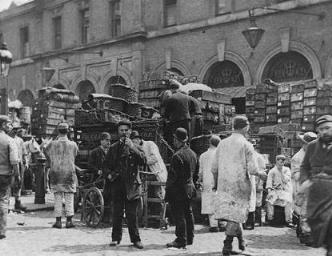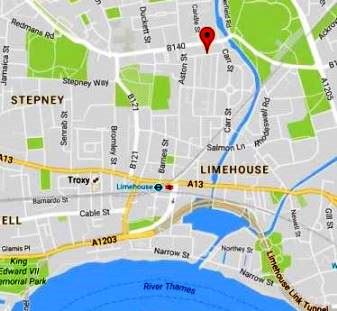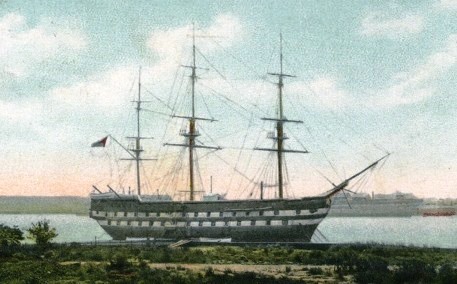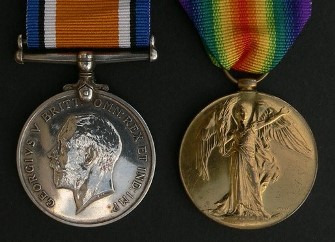charles christopher mellidine + margaret lydia grandy
Charles was born on 13 March 1865 at the family home on Trafalgar Place in Bethnal Green. He was the youngest son of Thomas Mallindine and his wife Elizabeth Evans. His father died before Charles’ third birthday and a year later, his mother remarried to John Rye who was likely the only father he knew.
Charles does not appear with his family in the 1871 census but there is a Charles Rye of the same age living with John’s brother, Thomas, at 10 Thomas Street in Bethnal Green. This Charles is listed as Thomas’ son but he does not appear in the next census and no birth or death records have been found to confirm this. It is possible that this is in fact Charles Christopher and he was staying with his step-uncle to relieve the pressure on his mother who was caring for her other three children.
In 1881, the family was living at 3 Carrows Buildings on Suffolk Street in Bethnal Green and 16 year old Charles was working as a Potman — someone employed in a public house to collect and wash glasses — along with his step-father. Charles was recorded under the name Rye rather than Mallindine and his relationship to John Rye was listed as son rather than step-son.
Charles’ mother died in 1888, aged only 50 years, but it is not known if he stayed with his step-father or moved into lodgings or with other family members. On 6 January 1891, Charles married Margaret Lydia Grandy at the church dedicated to St Mary in Whitechapel. Lydia was born on 27 June 1871 at 15 New Church Street in Bethnal Green to Frederick Grandy, a Boot Maker, and Margaret Alice Campbell. The marriage register listed his name as Charles Christopher Mellindine and neither he nor Lydia could read or write and both signed the register with only their mark. Over the years, the spelling of Charles’ surname in public records varied from Mellindine, Melondine, Millindine and finally the most common spelling of Mellidine.
When they married, they were both living at 12 Brick Lane where Charles was employed as a Fish Curer and when the Census was taken in April, they were still on Brick Lane but Charles’ occupation now read Fish Porter. There were seven families totalling twenty-one people living at number 12 and most of them including Charles and Lydia occupied only a single room in the house. Their son Thomas William was born about one month before the census, and only two months after his parents’ wedding, but no birth registration or baptism has been found under the name Mellindine. However there is a possible record under the surname Granby which could be an error transcribing Grandy and if this record relates to their son, it probably means he was born before they were married and they chose not to disclose this to the census enumerator. Sadly, little Thomas died at the London Hospital on 19 August and the cause of death was listed as Marasmus. According to an article in the National Georgraphic Quarterly magazine, Marasmus was:
‘a term used to describe malnutrition occurring in infants and young children, caused by an insufficient intake of calories or protein and characterized by thinness, dry skin, poor muscle development, and irritability. In the mid-nineteenth century, specific causes were associated with specific ages: In infants under twelve months old, the causes were believed to be unsuitable food, chronic vomiting, chronic diarrhea, and inherited syphilis. Between one and three years, marasmus was associated with rickets or cancer. After the age of three years, an enlargement of the mesenteric glands (located in the peritoneal fold attaching the small intestine to the body wall) became a given cause of wasting. After the sixth year, chronic pulmonary tuberculosis appeared to be the major cause.’
Charles and Lydia left Bethnal Green and moved further east to Stepney where their daughter Elizabeth was born in the spring of 1892. Charles Christopher was born on 1 August 1894 and when he was baptised at St John the Evangelist on Halley Street on 22 August, the family was living at 7 Dan Row in Limehouse.
At the time, Limehouse was a district in the borough of Stepney and stretched from Ben Johnson Road, now part of the B140, in the north to Limehouse Basin and the Thames in the south. The name has been in use since medieval times and refers to the lime kilns that once dominated the area.
Although the family remained in Limehouse for the next five years, they moved multiple times — first to Ebenezer Place, just off Halley Street, then Manning Street and finally Aston Street. But they never moved far, only a street or two away, and remained in a very small geographic area bordered by the commercial gas works to the north and the church of St Dunstan to the west.
On Booth’s poverty map, the streets around St John the Evangelist ranged from black or the lowest class to light blue or poor but Halley and Aston streets fared better with a ‘mixed’ rating of some comfortable, some poor. In his notebook, Booth mentions that many workers in the area were employed at the gas works but the area was also home to a large number of Haddock Curers ‘who can only work when haddocks are cheap as no one will buy them when they are dear.’
On 13 August 1896, Charles and Lydia lost a second child when Elizabeth died as a result of measles and pulmonary tuberculosis just after her fourth birthday; she was buried at Manor Park Cemetery in Newham on 19 August. Frederick was born on 14 February 1897 at 6 Manning Street followed by James Joseph, often recorded as Jim Joseph, on 7 January 1899 at 158 Aston Street.
Between 1899 and 1900, Charles and Lydia joined many other East End families and moved out of the city to neighbouring Essex settling initially in Canning Town where daughter Lydia Margaret was born on 23 July 1900. Strangely, Charles and Lydia appear in the 1901 census at 27 Duckett Street in Mile End Old Town where Charles was working as a Fish Porter but none of their four surviving children — Charles, Fred, Jim Joseph or Lydia — were living with them nor have they been found elsewhere.
But they returned to West Ham, settling in a house at 42 Marten Road, and Charles may have found a job on the Royal Victoria Docks as his occupation was listed as Dock Labourer until 1905 when he returned to working as a Fish Porter. In December 1903, their seventh child, Harry, was born but it doesn’t appear that they registered his birth, or those of 5 or 6 of his siblings, as required by law. Harry suffered from ill health and after suffering chronic diarrhea for two weeks, he died on 10 October 1904 and was buried at West Ham Cemetery in Newham the following day. Lydia gave birth to daughter Catherine, known as Kitty, only one week after Harry’s death, and she fell pregnant again shortly after as Mary was born, most likely prematurely, in the spring of 1905 but she died of Marasmus five months later and was buried at West Ham Cemetery on 8 August 1905.
William was born at 40 Coolfin Road in Custom House, an area between the Royal Victoria Dock and Canning Town, on 18 May 1906 but died the following year, on 26 July, from Tabes Masenterica which was a wasting disease in children caused by tuberculosis; he too was buried at West Ham Cemetery. Their eleventh child was born on 15 April 1908 at 32 Hemsworth Street in Canning Town and they named him William as well but like his namesake, he did not survive and died five months later of marasmus, diarrhea and exhaustion; he was buried at West Ham Cemetery on 28 September.
The family continued to struggle financially as Charles moved between jobs as a Fish Porter and a Dock Labourer and like many others, they moved often either in search of more affordable rent or to escape the rent collector. Their situation was worsened due to Charles’ chronic alcohol abuse and Lydia’s health problems which meant the children were often left to fend for themselves.
Thomas William was born on 7 July 1909 at 82 Adamson Road in Custom House and two years later, the family was living at 36 Scott Street near the Royal Victoria Docks in Canning Town. Forty-five year old Charles was once again working as a Fish Curer and five of their six surviving children — Fred, James, Lydia, Kate and Thomas — were also living in the three rooms they occupied.
Their eldest son, Charles, was living on the reformatory ship the Cornwall that was moored on the River Thames at Purfleet in Essex. The first training ships were established in the 18th century and their goal was to not only provide opportunities for young boys in the workhouses but to train them as future sailors in the Royal Navy.
The reformatory ships developed as a result of the Reformatory School Act of 1854 which sought to bring some structure to the growing movement, primarily driven by charitable organizations, to offer young offenders an alternative to adult prisons. The Act allowed schools to be certified as a reform school for young offenders and initially, they only accepted boys between the ages of 11 and 14 who had been committed to detention for three years or more but later some voluntary admissions were accepted. The focus of their education was on naval training but the boys were also taught other trades such as tailoring and carpentry. The Cornwall was operated by The School Ship Society and although they covered the majority of expenses, the boys’ parents were required to pay a weekly fee of up to 5 shillings which would have been a substantial sum for a family like the Mellidines so it seems likely that all his expenses were covered by the charity rather than his parents.
On 22 July 1913, their thirteenth and final child Henrietta, known as Hetty, was born in West Ham and shortly after, Lydia’s health declined to such an extent that she was forced to enter a sanitorium for tuberculosis patients. Unfortunately, Charles continued to drink and offered little support to his children so their fourteen year old daughter Lydia had to take on the responsibility of caring for her younger siblings, baby Hetty, five year old Thomas and nine year old Kitty. It is not known how much contact Charles had with his wife or their children had with their mother but when she was older, Hetty was told that her mother died giving birth to her.
One year later, the family was living at 80 Clarkson Street in Canning Town when the first of three sons joined the army. Charles enlisted with the Royal Highlanders in Perth, Scotland while working as a Ship’s Cook, Fred joined the Welch Regiment in July 1915 and James also enlisted in the same regiment but his enlistment date is not known. Following the war, all three were awarded the British War medal and the Victory medal in recognition of their service. Following his discharge from the army in 1919, Charles married Emily Morgan in West Ham and in 1922, Fred married Dorothy Williams at the Uxbridge Registry Office.
Only months before her 52nd birthday, Lydia died on 24 April 1923 from pulmonary tuberculosis at Whipps Cross Hospital in Leyton, Essex and her daughter Lydia Margaret acted as the informant. She suffered from the disease for many years and it may explain why so many of her children died in infancy. The disease can be transmitted from mothers to their babies and the initial symptoms of TB in infants are flu like symptons such as fever, cough and diarrhea. Lydia was buried at West Ham Cemetery on 1 May.
Less than one year later, their daughter Lydia was preparing to leave home and marry but with Charles unable to care for his youngest daughter, he made the decision to place eleven year old Hetty in the Aldersbrooke Children’s Home in Wanstead and he did not see her again for 25 years. He became completely estranged from the rest of his family as they chose not to have contact with him due to his drunkeness and ill treatment of them as children.
Lydia Margaret married Frederick Robert Vick in West Ham in the early months of 1924. Fred was born on 17 October 1902 to Ernest Augustus Julius Vick and Beatrice Caroline Gage and in 1911, he lived on Clarkson Street near the Mellidine family. A year after the birth of their first son in 1925, Fred joined the Merchant Navy and left on his first voyage on board the Plutarch as a Trimmer who was responsible for moving the coal from the bunkers to the stoke holds. He likely took the job on the recommendation of his brothers-in-law, Charles and Jim Joseph, who were already working as Merchant Seamen. Lydia and her husband had four more children and Fred eventually left the Merchant Navy and worked as a Dock Labourer. When Lydia and the children were evacuated to Cranbrook in Kent at the start of the war, Fred stayed in West Ham and lived with his brother-in-law Thomas at 30 Clarkson Street. After the war, they lived in the Beckton area of West Ham near the London City airport. Lydia died of heart failure at St Ann’s Hospital in Tottehnam on 29 July 1985 and Fred died in 1992.
Catherine married Thomas Mitchell in Battersea in 1936 but they did not have any children. After her husband died and her health started to fail, Catherine moved into the Gibson Lodge Nursing Home in Norbury in south London. She died there of stomach cancer on 1 August 1991.
Their youngest daughter Hetty married Benjamin Thomas Davis on 3 March 1940 at Holy Trinity Church in Wanstead, Essex. Benjamin was born in Stratford on 17 June 1916 to Henry Davis and Elizabeth Woodward and the year before their marriage, Benjamin was living with his parents at 81 Maybank Road in Woodford and working as a Carpenter. Hetty and Benjamin had two children and lived in Woodford Green for many years. Benjamin died at Whipps Cross Hospital in Leytonstone on 26 January 1994 and following his death, Hetty moved into the Greenmantle Rest Home in Woodford. She died at Whipps Cross on 15 July 1997.
Son Thomas was thirty-one years old when he married eighteen year old Doris Grace Whitelaw at St Edmonds in East Ham on 2 May 1941. Their first daughter, Maureen Grace, was born later that year but sadly died just before her thirteenth birthday. After the war, Thomas and Doris had three more children and settled in the West Ham area. Thomas died of cancer on 10 October 1969 at St Joseph’s Hospice in Hackney. Doris lived on Dongola Road in East Ham for many years; she died in 2008.
In 1939, Charles was an inmate in the Forest Gate Hospital and was listed as ‘incapacitated’ along with many others in the same ward. After a chance encounter in 1952, Hetty made contact with her father and agreed to occasional visits on Sundays but her siblings did not want to see him. On 28 September 1956, Charles died, aged 91 years, at Forest House in James Lane, Leytonstone. Forest House was an estate that at various times in its history was used as a Workhouse and an infirmary for returning soldiers; it was also located next to the Whipps Cross Hospital and may have been taken over by the hospital as it expanded. The cause of death was broncho-pneumonia and emphysema and on 4 October, Charles was buried at West Ham Cemetery in Newham but it is not known if he was buried near his wife and children.



